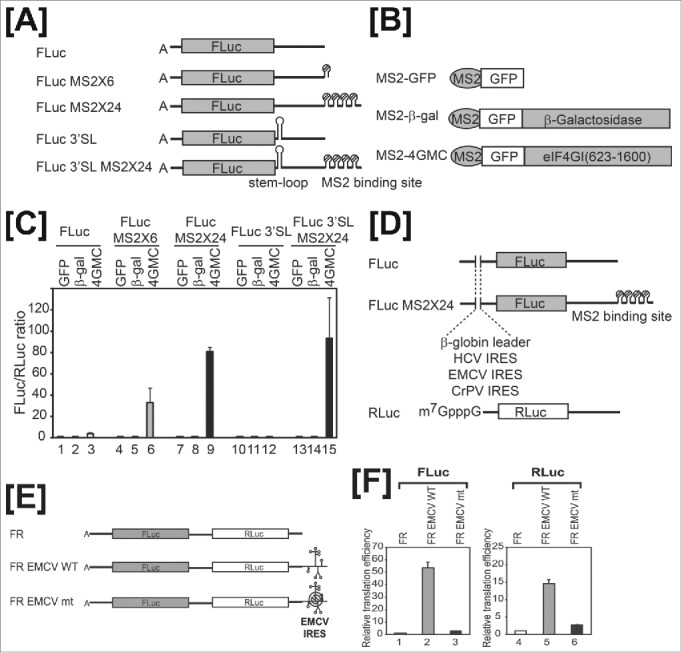Figure 2.

A 40S ribosomal subunit recruited to the 3′UTR of mRNA augments translation of upstream reporter genes. Panels [A] to [D] are modified versions of Fig. 1 from reference 2. [A] FLuc represents a reporter RNA containing the firefly luciferase gene as a reporter. MS2-binding sites (6 or 24 copies) were inserted into the reporter RNA to generate FLuc MS2 × 6 and FLuc MS2 × 24, respectively. A stable stem-loop was inserted downstream of the stop codon of reporter RNAs, FLuc and FLuc MS2 × 24, to generate FLuc 3′SL and FLuc 3′SL MS2 × 24, respectively. [B] Schematic diagram of MS2 fusion proteins. [C] The translation efficiencies of FLuc (lanes 1–3), FLuc MS2 × 6 (lanes 4–6), and FLuc MS2 × 24 (lanes 7–9) were determined by measuring firefly luciferase activity in cells expressing MS2-GFP (lanes 1, 4, and 7), MS2-GFP-β-galactosidase (lanes 2, 5, and 8), or MS2-GFP-eIF4G (lanes 3, 6, and 9). Firefly luciferase activity was normalized to that of Renilla luciferase. [D] Schematic diagram of reporter mRNAs. Each reporter contains a G-capped β-globin leader, HCV IRES, EMCV IRES, or CrPV IRES at the 5′UTR. G-capped reporter RNA containing the Renilla luciferase gene (Rluc) served as a control for mRNA transfection efficiency. Panels [E] and [F] are modified versions of Fig. 4 from reference 2. [E] Dual reporters contain the firefly luciferase gene (FLuc) followed by the Renilla luciferase gene (RLuc). Wild-type (WT) or mutant (mt) EMCV IRES resides at the 3′UTR of reporters. [F] ApppG-capped reporters were in vitro-translated using nuclease-untreated rabbit reticulate lysates in the presence of 150 mM KCl. Graphs depict 5′-end–dependent (FLuc, lanes 1–3) and -independent (Rluc, lanes 4–6) translation. Activity was normalized to firefly and Renilla luciferase activities of the FR reporter without EMCV IRES (defined as 1).
